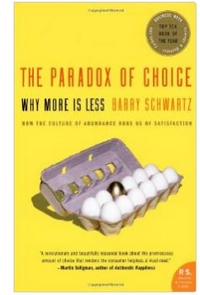Offering too many choices might lead to more abandoned shopping carts.

The premise of the book is that more choice doesn’t necessarily mean more satisfaction. It can lead to regret, dissatisfaction, and indecision.
The book references a report by Columbia and Stanford researchers called “When Choice is Demotivating” (pdf).
One of the field experiments in the report involved a sample station at a gourmet food store. One of the sample stations had six different jams that customers could taste. They were given a $1 off coupon if they wished to purchase one. In the other case, the sample station had 24 different jams that customers could taste. They were also given the coupon.
Were the people presented with 6 choices or 24 choices more likely to buy?
Six. By a long shot. 30% of those that were presented with six jams to taste bought one. Only 3% of those presented with 24 choices bought one.
This type of result is repeated over and over again in studies. When faced with too many options, people often select no option.
Domain name registrars should take note when presenting domain name options.
This is not a problem originated by new TLDs, although it certainly exacerbates the problem. Even before new TLDs hit the market, registrars returned dozens or hundreds of options for each domain lookup.
The key is presenting options in a limited way, while also offering to show more options to users who want them. It boils down to a user design problem: making it simple for those that desire simplicity and offering choice to those that demand it.
From this perspective, few domain name registrars are succeeding. Perhaps the best is Uniregistry, which shows six options and a link to view more.
Here are how many choices I see at various registrars after doing a domain search:
Hover 100 (because I stopped counting)
Name.com 33
Register.com 32 (but just four non-premium options are shown and separated)
GoDaddy 10
1&1 8
You might argue that domain search is different. Someone came to the store determined to leave with a jar of jam. But what if the one jam they wanted was out of stock? Then they’re faced with a choice again.
They search for something.com.
Show them if something.com is taken. If so, show them if they can purchase it as a premium domain.
If not, show them 2-3 alternative extensions or variations on the .com string.
Then if they want to dig in, give me them the option to see more choices.
I’m convinced that showing the right 5 or 6 options beats showing dozens of options every time. It may be that showing every option is just a default for poor domain search technology.






Yes got to concur with the sentiments of this article. When I visit say Dynadot you are met with a mass of different tld’s and although I know I want .com and .net a lot of new customers will be sooooo confused.
Well said. The funny thing is the new TLDs add a double whammy of confusion, one for the domain buyer, and the other for website visitors, who have no idea what these alternatives are or what the differences are.
Great point Andrew. That’s like the feeling I get when I go to an office supply story in need of some new pens and I find myself staring at a whole wall of them, in dozens of assortments. I don’t like it.
Couldn’t agree more. Having so many choices will make a lot of people think twice especially with all these new TLDs.
How do people ever manage to name their children? Or, for that matter, choose a partner with which to have them?
Naming their children is a necessity, buying jam or registering a new gTLD is not, they can settle for another available .com
I believe that naming children and picking a partner is a very tough life decision often involving regret, dissatisfaction, and indecision.